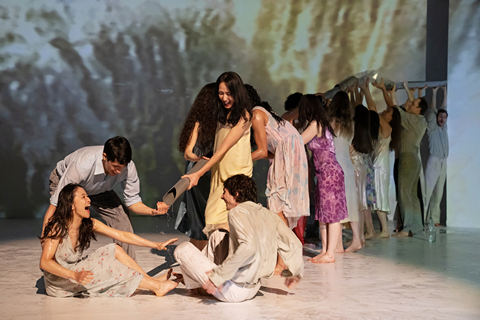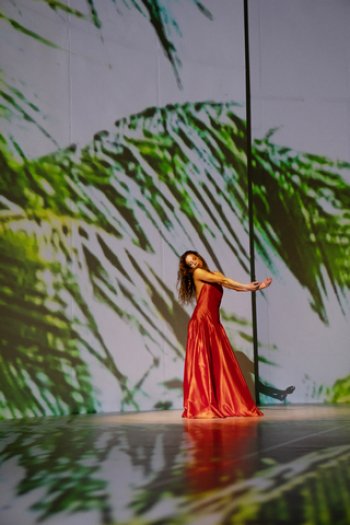Tanztheater Wuppertal Pina Bausch: Água
The American premiere of a world famous choreographer’s ballet disappoints with its languorous length and disconnected structure.

Tanztheater Wuppertal Pina Bausch in a scene from “Água” at Howard Gilman Opera House at Brooklyn Academy of Music (Photo credit: Julieta Cervantes)
[avatar user=”Joel Benjamin” size=”96″ align=”left”] Joel Benjamin, Critic[/avatar]
The German choreographer/director Pina Bausch died in 2009 leaving behind a generous theatrical legacy at Tanztheater Wuppertal Pina Bausch, including her two most famous works: Café Műller (1985) and The Rite of Spring (1975). The latter, circulated around the world via a televised version, was the making of her international reputation and led to her troupe’s many appearances at the Brooklyn Academy of Music.
Água, making its American debut, created in 2001 during a residency in Brazil, is a work of great beauty, humor and creativity —and dishearteningly, an overlong dance/theater work. Even the most beloved visitor who overstays his welcome, enervates rather than stimulates. Its series of discrete sections never congealed into a seamless whole, each, though fascinatingly staged and performed by this impeccable troupe, not making much sense even in the surreal world of Bausch’s imagination.
As usual, Bausch combined speaking with movement, not pairing them particularly smoothly in this work. Água actually began with a dancer speaking as she peeled and ate an orange, going on about a muscle cramp that caused her to leave her bed and gaze at the heavens through her window.
Later, another dancer in a long, pale gown, belies her beauty with a long gawky, self-deprecating monologue and rangy solo which was interrupted by passing male dancers. Later still, a young lady in a chiffon floral-patterned dress also chatters on, soon lifted by a man, her legs bicycling in the air.

Emma Barrowman of Tanztheater Wuppertal Pina Bausch in a scene from “Água” at Howard Gilman Opera House at Brooklyn Academy of Music (Photo credit: Julieta Cervantes)
Despite the chatter, there was actually plenty of beautiful dancing in Água, some of the most balletic choreography of any Bausch works, proving the large cast to be proficient theater artists who combine ballet, modern, ballroom, mime and acting. These company members are totally in synch with Bausch’s theater/dance spirit despite her being sadly and suddenly gone more than a decade ago. They are in tune with the wit and sexuality of Bausch’s vision and perform it all lustily and with technical perfection.
Towards the end, a man in an expansive black skirt twirled and bounced, soon joined by the last noted monologist/dancer. They both tossed themselves about, his voluminous costume parachuting and her long, dark hair dancing its own choreography.
White couches were rolled in forming a semi-circle. The cast sat, prostrated themselves, smooched and danced on and with these moveable props. Small round white café tables become Brazilian theme park rides, the male dancers sitting on them and twisting about making them scurry across the stage.
For most of the work, the women wore long, silky, sleeveless gowns in many colors and the men formal looking suits, that is until towards the end when most of the cast stripped down to swimwear, sometimes covering their half-naked bodies with beach towels emboldened with images of naked body parts. Marion Cito designed the costumes.

Taylor Drury of Tanztheater Wuppertal Pina Bausch in a scene from “Água” at Howard Gilman Opera House at Brooklyn Academy of Music (Photo credit: Julieta Cervantes)
There was a disturbing theme of quiet misogyny running through Água. Women are awkwardly lifted under their arms, tossed to the ground, twirled upside-down and otherwise handled with a lack of dignity.
The truly absurd ending seemed to have been tacked on to justify the title. The dancers, now more informally attired, swallow water from bottles and spit it out in sprays at each other until they are all soaking wet.
All these vignettes are accompanied by a giddy series of musical selections chosen with collaborators Matthias Burkert and Andreas Eisenschneider, including sambas, bossa nova, Afro-Caribbean, pop songs, jazz and new age.
The set, created by Peter Pabst, provides three huge white panels onto which Pabst’s vivid tropical-themed videos are projected—waving palm fronds, beaches, a percussion street band, splashing waterfalls, primates cavorting in trees and endless forests—both adding to and overwhelming the action unfolding before them. These upright panels are raised towards the end of the work to reveal a thicket of trees that cleverly come apart to be carried by the cast members.
The Bausch troupe is now directed by the French choreographer Boris Charmatz. Perhaps BAM will bring back the troupe with his choreography in tow, maybe even a program combining the works of the two choreographers.
Tanztheater Wuppertal Pina Bausch: Água (March 3 – 18, 2023)
Howard Gilman Opera House at the Brooklyn Academy of Music, 30 Lafayette Avenue, in Brooklyn
For tickets, call 718-636-4100 or visit http://www.BAM.org
Running time: two hours and 50 minutes including one intermission






Leave a comment